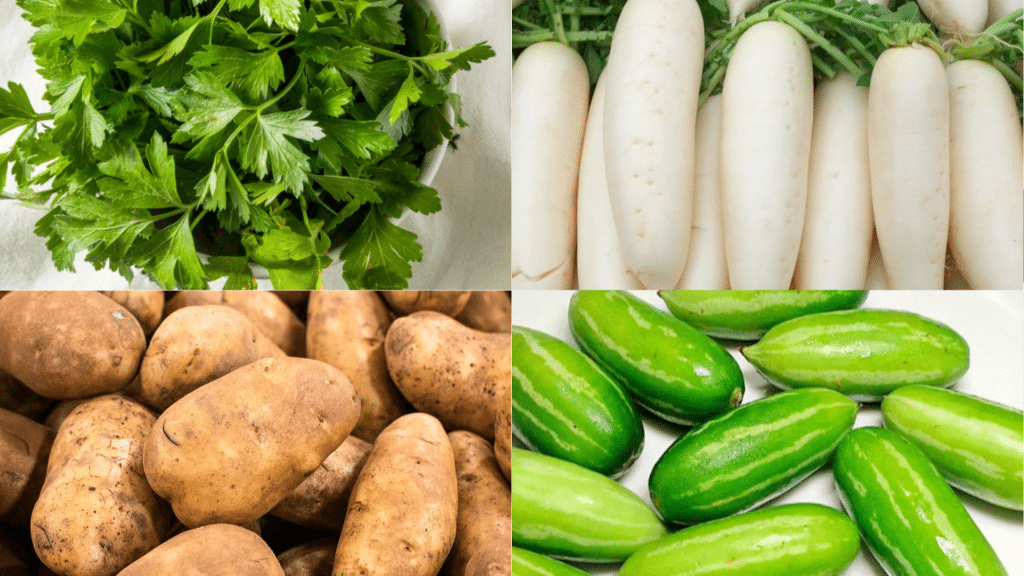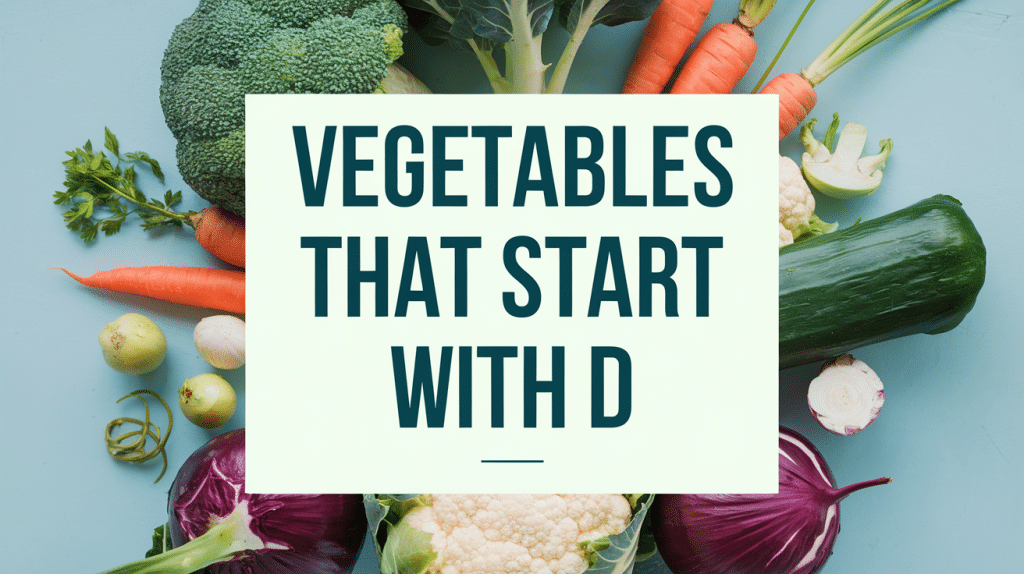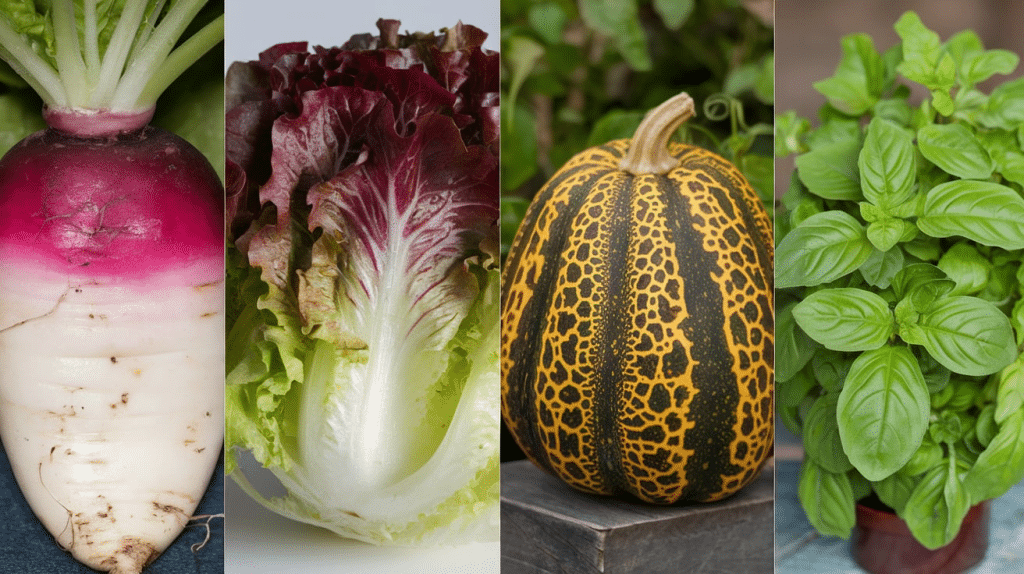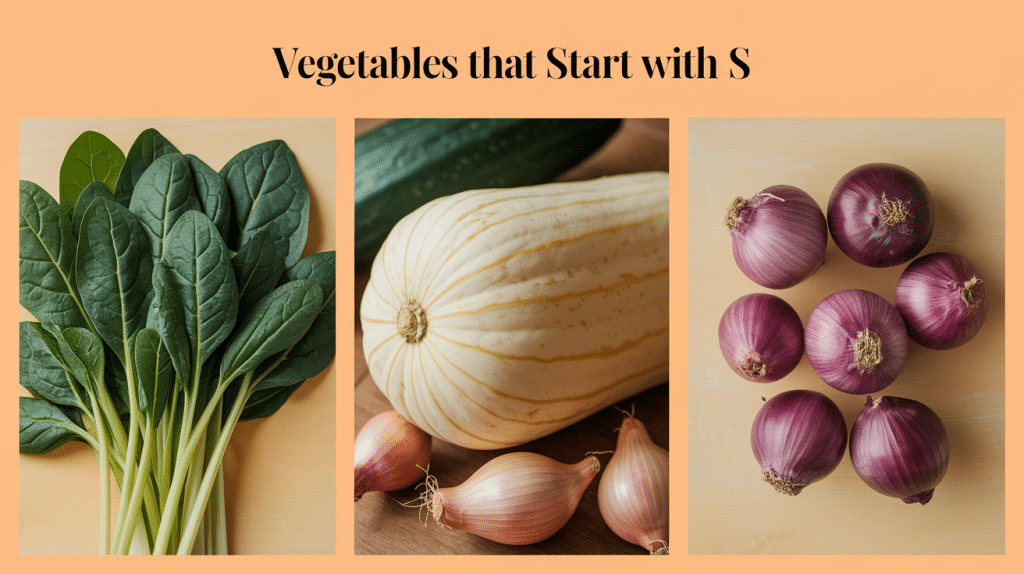Now Reading: 25 Vegetables that Start with the Letter D
-
01
25 Vegetables that Start with the Letter D
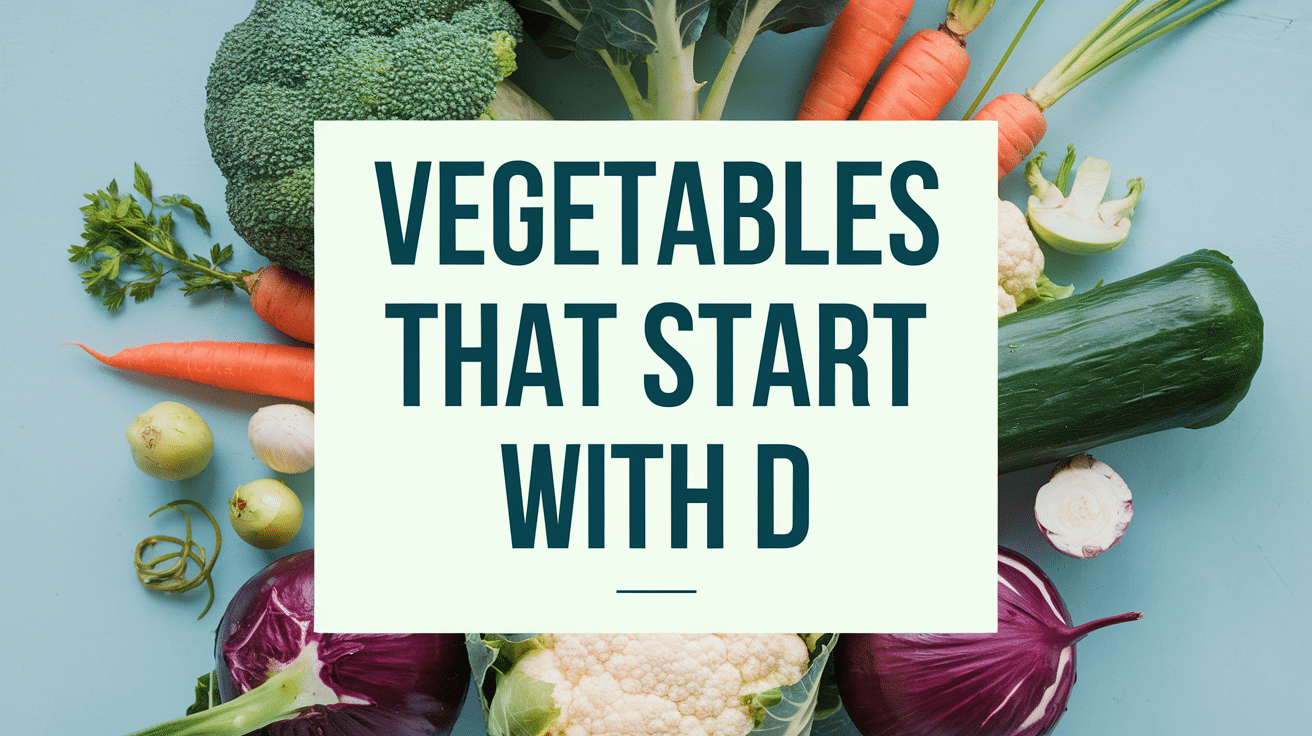
25 Vegetables that Start with the Letter D
Are you looking to add more variety to your meals?
Let’s explore some vegetables that start with D!
From the mild, crunchy Daikon to the flavorful, nutrient-packed Dahlia Tubers, these vegetables are not only delicious but also offer numerous health benefits.
Many of these veggies are packed with vitamins, fiber, and antioxidants, making them a great addition to your diet.
No matter you’re looking to try something new or incorporate them into your regular meals, the vegetables that start with D are sure to offer a fresh twist to your cooking.
Ready to explore some amazing options for your next dish? Let’s dive in!
Vegetables that Start from D
1. Daikon

Daikon is a long, white radish with a mild, slightly sweet flavor. It is often used in Asian cuisine and is popular for its crunchy texture and ability to absorb flavors in dishes.
- Origin: East Asia
- Scientific Name: Raphanus Sativus
- Uses: Daikon Is Used in Salads, Pickles, Stir-Fries, and Soups.
- Health Benefits: High in Vitamin C, Supports Digestion, Boosts Immune Function, and Helps with Detoxification.
2. Dandelion Greens

Dandelion Greens are leafy, bitter-tasting greens commonly found in wild areas; these greens are packed with nutrients and are known for their ability to cleanse the liver and support digestion.
- Origin: Native to Eurasia
- Scientific Name: Taraxacum Officinale
- Uses: Often Used in Salads, Soups, Teas, or As a Cooked Vegetable.
- Health Benefits: High in Antioxidants, Supports Liver Health, and Boosts Immune Function.
3. Delicata Squash

Delicata Squash is a small, cylindrical winter squash with a thin, edible skin; its sweet, creamy flavor makes it ideal for roasting, stuffing, or adding to various savory dishes.
- Origin: North America
- Scientific Name: Cucurbita Pepo
- Uses: Roasted, Baked, or Stuffed in Savory Dishes.
- Health Benefits: Rich in Vitamins a And C, Promotes Heart Health, and Has Anti-Inflammatory Properties.
4. Drumstick

Drumstick, or moringa, is a versatile plant known for its long, slender pods and nutritious leaves; it has a mild, slightly peppery flavor and is often used in soups and curries.
- Origin: India, Southeast Asia
- Scientific Name: Moringa Oleifera
- Uses: Leaves Used in Soups, Powders, and Teas.
- Health Benefits: High in Vitamins, Antioxidants, and Anti-Inflammatory Compounds. Improves Digestion and Energy Levels.
5. Dwarf Beans

Dwarf Beans are small, bushy plants that grow compactly and produce tender, sweet beans; they are known for their quick growth and ease of cultivation, perfect for small gardens.
- Origin: Native to Central and South America
- Scientific Name: Phaseolus Vulgaris
- Uses: Eaten Fresh or Cooked in Soups and Stews.
- Health Benefits: Rich in Fiber and Protein, Supports Digestive Health and Blood Sugar Regulation.
6. Donggua (winter Melon)

Donggua is a large, cylindrical green vegetable with a mild, slightly sweet flavor; it’s commonly used in soups, stir-fries, and curries due to its versatility and refreshing texture.
- Origin: Asia
- Scientific Name: Benincasa Hispida
- Uses: Used in Soups, Stir-Fries, and Beverages.
- Health Benefits: High in Water Content, Promotes Hydration, Supports Weight Management, and Aids in Digestion.
7. Dutch Horn Carrot

The Dutch Horn Carrot is a long, tapered variety known for its sweet, crisp texture; it is often used in salads, soups, or roasted dishes, and it retains a deep orange color when cooked.
- Origin: Netherlands
- Scientific Name: Daucus Carota
- Uses: Eaten Raw, Roasted, or Used in Soups and Salads.
- Health Benefits: Rich in Beta-Carotene, Promotes Eye Health, Boosts Immune Function, and Supports Healthy Skin.
8. Durban Cabbage

Durban Cabbage is a hardy green cabbage with a mild, slightly sweet flavor; it is often used in stews, soups, or as a side dish, known for its tender texture and adaptability to various dishes.
- Origin: South Africa
- Scientific Name: Brassica Oleracea
- Uses: Used in Soups, Stews, and Stir-Fries.
- Health Benefits: High in Vitamin C, Promotes Digestive Health, and Provides Anti-Inflammatory Properties.
9. Daubenton Kale

Daubenton Kale is a perennial variety of kale known for its tender, curly leaves; it has a milder flavor compared to other kales and can be harvested year-round, making it a sustainable and nutritious choice.
- Origin: Europe
- Scientific Name: Brassica Oleracea
- Uses: Used in Soups, Salads, Stir-Fries, and Smoothies.
- Health Benefits: Rich in Vitamins A, C, and K, Supports Immune Function, Promotes Heart Health, and Provides Anti-Inflammatory Properties.
10. Dune Spinach

Dune Spinach, also known as New Zealand spinach, is a leafy green vegetable with a mild, spinach-like flavor; it thrives in sandy soils and is commonly used in salads and cooked dishes.
- Origin: New Zealand
- Scientific Name: Tetragonia Tetragonioides
- Uses: Used in Salads, Soups, and As a Cooked Green.
- Health Benefits: High in Vitamins a And C, Supports Eye Health, and Provides Anti-Inflammatory Benefits.
11. Dutch Yellow Cress

Dutch Yellow Cress is a leafy green with a peppery taste, similar to watercress; it thrives in moist conditions and is often used in salads, sandwiches, and garnishes for its bold flavor and vibrant color.
- Origin: Netherlands
- Scientific Name: Lepidium Sativum
- Uses: Used in Salads, Sandwiches, and As a Garnish.
- Health Benefits: High in Vitamin C, Supports Immune Health, Aids Digestion, and Has Anti-Inflammatory Properties.
12. Dragon Tongue Beans

Dragon Tongue Beans are a unique, striking bean variety with purple and yellow streaks on flat, tender pods; they are often used in salads, stir-fries, or as a side dish.
- Origin: Europe
- Scientific Name: Phaseolus Vulgaris
- Uses: Used in Stir-Fries, Salads, and Cooked Dishes.
- Health Benefits: Rich in Protein, Fiber, and Antioxidants, Promotes Heart Health, and Helps Regulate Blood Sugar.
13. Dragon Fruit Cactus (pitaya)

Dragon Fruit Cactus produces vibrant, pink or yellow fruits with white or red flesh speckled with small black seeds; the flesh has a mildly sweet flavor and is often used in smoothies or salads.
- Origin: Central America
- Scientific Name: Hylocereus Undatus
- Uses: Eaten Fresh, Used in Smoothies, Salads, or Desserts.
- Health Benefits: Rich in Antioxidants, Vitamin C, and Fiber, It Supports Digestion, Boosts the Immune System, and Promotes Healthy Skin.
14. Double-Curled Parsley

Double-Curled Parsley is a decorative herb known for its finely curled, bright green leaves; it has a mild, slightly peppery flavor and is often used as a garnish in a variety of dishes.
- Origin: Mediterranean Region
- Scientific Name: Petroselinum Crispum
- Uses: Used as A Garnish, in Salads, Soups, and Sauces.
- Health Benefits: Rich in Vitamins A, C, and K, Supports Immune Health, and Has Anti-Inflammatory Properties.
15. Divi-Divi (vegetable)

Divi-Divi, primarily known as a legume, is often used as a vegetable in some regions; its pods are used for their flavor in savory dishes or ground into powder for seasoning.
- Origin: South America, Caribbean
- Scientific Name: Caesalpinia Coriaria
- Uses: Used in Savory Dishes, Sauces, and Spice Blends.
- Health Benefits: Contains Antioxidants, Helps Regulate Blood Sugar Levels, and Supports Digestive Health.
16. Dutch Cabbage

Dutch Cabbage is a variety of cabbage known for its firm, compact head and mild, sweet flavor; it is used widely in European cuisines for making slaws, soups, and stir-fries.
- Origin: Netherlands
- Scientific Name: Brassica Oleracea
- Uses: Used in Coleslaw, Soups, Stir-Fries, or As a Side Dish.
- Health Benefits: High in Vitamin C, Promotes Digestion, and Helps with Detoxification.
17. Dandelion Root

Dandelion Root, when used as a vegetable, is often cooked or dried and used in teas; it has a slightly bitter taste and is known for its detoxifying properties and earthy flavor.
- Origin: Native to Eurasia and North America
- Scientific Name: Taraxacum Officinale
- Uses: Used in Soups, Teas, or As a Cooked Vegetable.
- Health Benefits: Supports Liver Health, Promotes Digestion, and Has Diuretic Properties.
18. Damson Plum

Damson Plums are small, tart plums used occasionally in savory vegetable recipes; their intense, tart flavor makes them ideal for sauces, chutneys, and savory dishes.
- Origin: Europe, Asia
- Scientific Name: Prunus Domestica
- Uses: Used in Sauces, Chutneys, and Savory Vegetable Recipes.
- Health Benefits: High in Antioxidants, Supports Digestion, and Improves Heart Health.
19. Danish Butterhead Lettuce

Danish Butterhead Lettuce is a soft, tender variety of lettuce known for its mild, sweet flavor and smooth, buttery texture; it is often used in salads and sandwiches for a fresh, crisp bite.
- Origin: Denmark
- Scientific Name: Lactuca Sativa
- Uses: Used in Salads, Wraps, or As a Garnish.
- Health Benefits: Low in Calories, High in Vitamins a And K, Supports Digestion, and Aids Hydration.
20. Desert Eggplant

Desert Eggplant, also known as prickly pear eggplant, is a small, spiny vegetable found in desert regions; it has a mild, slightly bitter taste and is used in various cooked dishes and stews.
- Origin: Deserts of North America
- Scientific Name: Solanum Elaeagnifolium
- Uses: Used in Stews, Curries, and Roasted Dishes.
- Health Benefits: High in Fiber and Antioxidants, Supports Digestive Health, and May Aid in Blood Sugar Regulation.
21. Desert Lime (used in Some Vegetable Preparations)

Desert Lime is a small, citrus fruit native to Australia, known for its tart, tangy flavor; it is used in vegetable preparations for its intense citrus flavor, often in dressings or chutneys.
- Origin: Australia
- Scientific Name: Citrus Glauca
- Uses: Used in Dressings, Chutneys, or As a Garnish in Vegetable Dishes.
- Health Benefits: Rich in Vitamin C, Boosts Immune Health, and Acts as An Antioxidant.
22. Double-Leafed Kale

Double-Leafed Kale is a leafy green with a mild flavor and a tender texture; it is known for its beautiful green leaves that are rich in nutrients, commonly used in salads and smoothies.
- Origin: Europe
- Scientific Name: Brassica Oleracea
- Uses: Used in Salads, Soups, and Smoothies.
- Health Benefits: Packed with Vitamins A, C, and K, Supports Immune Function, Promotes Healthy Skin, and Has Anti-Inflammatory Properties.
23. Drunken Woman Lettuce

Drunken Woman Lettuce is a unique leafy green with a distinct, slightly bitter taste; it’s often used in salads and garnishes and is known for its mildly aromatic and refreshing flavor when eaten raw.
- Origin: Europe
- Scientific Name: Lactuca Virosa
- Uses: Used in Salads, as A Garnish, or In Herbal Teas.
- Health Benefits: Known for Its Calming Properties, It Can Promote Relaxation and Help with Digestion. It Also Contains Vitamins a And C.
24. Dulse

Dulse is a type of edible seaweed, often found in the North Atlantic; it has a savory, salty taste and is used in salads, soups, or as a snack. It is rich in minerals and vitamins.
- Origin: North Atlantic Ocean
- Scientific Name: Palmaria Palmata
- Uses: Used in Soups, Salads, as A Snack, or In Sandwiches.
- Health Benefits: High in Iodine, Supports Thyroid Health, Boosts Immune Function, and Is a Good Source of Iron and Antioxidants.
25. Dahlia Tubers

Dahlia Tubers are the underground storage organs of the dahlia plant; these root vegetables have a sweet, nutty flavor and a starchy texture, often used in savory dishes or mashed as a potato alternative.
- Origin: Mexico
- Scientific Name: Dahlia Pinnata
- Uses: Used in Soups, Stews, Salads, or Roasted as A Side Dish.
- Health Benefits: High in Fiber, Supports Digestive Health, and Provides Essential Vitamins and Minerals.
Conclusion
Incorporating vegetables that start with d into your meals is a simple way to enhance both flavor and nutrition.
If you enjoy the mild taste of daikon, the richness of drumstick, or the versatility of dandelion greens, there’s a variety to suit every taste.
These vegetables are not only delicious but also packed with essential nutrients that support overall health.
So, why not step out of your usual routine and experiment with these unique vegetables in your next meal?
From Soups and Salads to Stir-Fries, There’s so much to explore.
By adding these vegetables that start with D to your diet, you’ll enjoy a diverse and nutrient-rich menu every day!

















